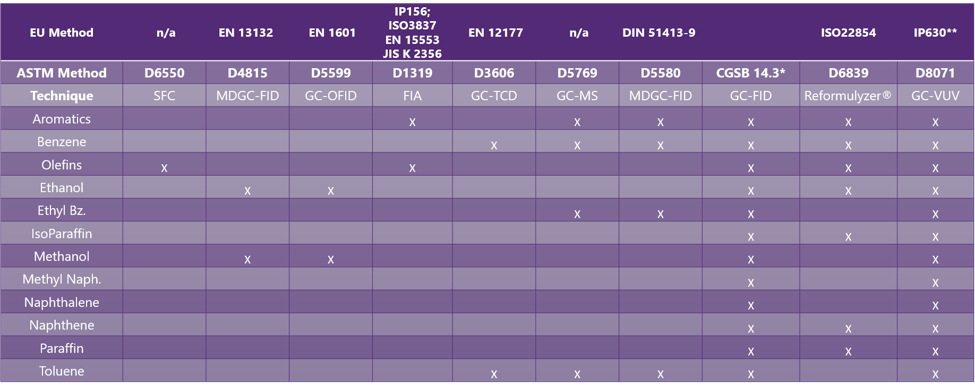Published Dan Wispinski on February 5, 2020
Finished Gasoline Analysis and the State-of-Affairs with ASTM D8071
If you are new to VUV Analytics or have been following us for some time, you no doubt know that one our primary areas of focus is hydrocarbons. More specifically, hydrocarbon analysis as it pertains to the oil and gas industry.
The year 2019 was a busy one for VUV Analytics and for me personally. We launched the VUV Analyzer™ Platform for fuels, completed our ILS for ASTM D8071 resulting in the final approval and publication of that method, and introduced a new method for jet fuel analysis (ASTM D8267). I am proud of that last one as our team here in Austin, introduced the method, ran a complete ILS, balloted the complete method and gained official approval as a test method in less than a year. I am told that is something of a record. As I write this, we are currently in the process of balloting that method for inclusion into the Jet Fuel Specification – ASTM D1655. More on that in a future blog.
Anybody that has gone through the process of seeking approval for methods like this know that it is not a trivial process. One of the critical elements of the process is the discussion and debate that happens at the semi-annual ASTM D02 meetings.
The most recent meeting, having occurred this past December 2019, was no different. So much happened related to ASTM D8071 and ASTM D8267 that I decided to break this blog into two parts. Part 1 outlines the key happening surrounding ASTM D8071-19 for finished gasoline analysis while Part 2 will delve a little deeper into ASTM D8267-19a and the current situation surrounding jet fuel analysis.
Finished Gasoline Analysis – ASTM D8071-19
While at the ASTM meeting in New Orleans, I had the pleasure of presenting updates to the D02.4L GC committee on ASTM D8071-19 on the significant updates and progress made since the method was approved with its formal research report and precision statement. Final publication of the standard occurred in September 2019. This was a significant milestone for us as this method was first approved in early 2017 and represented the culmination of a tremendous amount of work.
While this is significant to us here at VUV Analytics, it is perhaps more significant to the market. You may be asking “why?”:
- First off, this method represents a significant advancement in accuracy since it uses spectral validation. Since compounds of interest have unique spectral shapes, they can accurately be identified using D8071 (GC-VUV). Additionally, these unique spectra will have similar shapes based on their class. This means that they can be easily and accurately combined by class which is critical to PIONA analysis.
- Second, it is easy-to-use. This is true for a variety of reasons. Unlike other approaches this method is completely automated. All the user must do is load their samples (no sample prep required), acquire the data, and press analyze.
- Third, this method covers a broad set of parameters (See Table 1), in fact this one method can be used to replace many of the methods shown in Table 1. This reduces complexity in the laboratory, increases productivity, reduces costs, and allows for better utilization of laboratory personnel.
- With the most recent publication, this method now includes the EPA referee correlation equations which are automatically reported through the VUV Analyze software. In fact, our clients are now adopting 8071 for EPA CFR 80.47 reporting requirements.
What is next for this method?
It would be easy to stop at this point. However, we are working on several exciting enhancements to the method. Two in particular:
- With success of ASTM D8071-19 in the United States, we initiated a Canadian General Standards Board (CGSB) study to determine an ASTM D6708 correlation to the referee Canadian Detailed Hydrocarbon Analysis (DHA) method. This means ASTM D8071 has the potential to be used in place of the time intensive DHA method used today and will be balloted into CGSB gasoline specifications and Canadian environmental regulations. Initial results are very promising and indicate that ASTM D8071-19 has very favorable precision comparisons to these parameters.
- Our work on gasoline standard methods is not stopping as we are actively developing IP630, a new method for gasoline analysis for use in Europe. This method is based on D8071 and extends to other oxygenates, including ethers.
I will continue to update you on new developments in future blogs.
In Part 2 of this blog, I will discuss the current state of Jet Fuel Analysis on where we currently stand on a solution.











Nicely presented.